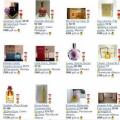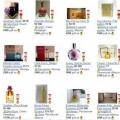How to make yo-yo flower from fabric. Yo-Yo decorative flowers
Good afternoon, dear readers!
While browsing the Internet, I find so much interesting on the way, previously unknown techniques and unusually beautiful products, such as interesting bedspreads and napkins made of three-dimensional fabric colors. And here I was interested in how to do yo-yo flowers. Rather, just such flowers made of fabric, at first I did not know that they are so called.
Flowers decorated with a button are more or less clear, but how do you get flowers with such a “hole” at the top?
Having understood, I learned that this technique of making flowers is called yo-yo. And it turned out to be very simple.
History of the name of the yo-yo technique
The history of the name of this technique is quite interesting. She was born in the 17th century in England and first bore the name “Saffon Puffs” by the name of the county. In those days, expensive fabrics appeared and people cherished every shred remaining after cutting clothes and other things. They came up with the idea of \u200b\u200bmaking flowers from flaps of fabric - poufs, sewed them together in tablecloths, bedspreads, panels. For the manufacture of flowers used and old well-worn clothing.
The fashion for voluminous flowers made of fabric was revived at the beginning of the 20th century. At that time, a wooden toy yo-yo appeared in the Philippines (which means “go-go”), which consists of two circles connected by a jumper. A thread was wound around the jumper, the toy was thrown to the floor - the thread was unwound, then lifted up, again winding the thread.
Strange fun, in my opinion.
But someone came up with the name of this toy to name the technique of making flowers, most likely because two short syllables are easier to pronounce than two words “Saffon puffs”.
These flowers made of yo-yo fabric did not begin to be called immediately. Their first name is Suffolk Puffs, originally from England, namely from Suffolk County. In the 17th century, the flowering of silk and spinning industry was observed in Suffolk. Due to the high cost of new fabrics, needlewomen tried to keep every shred remaining after cutting. And then from these residues they learned to make artificial flowers with their own hands - volumetric poufs. Old clothes were also used, from which more or less decent sections were cut out. The ottomans began to be stitched together in a circle or in rows and thus created large bedspreads and tablecloths.
Why are the Suffolk Puffs now called yo-yo? The story is very interesting. At the beginning of the 20th century, voluminous parts from shreds again entered fashion. At the same time, a small wooden toy, called yo-yo, was brought in with Phillipin, which means “go-go” or “round-trip” in translation from the Philippines. The toy looks like this (two flat circles interconnected by a narrow jumper)

It was necessary to wind a rope around this jumper, after which the toy dropped to the floor, unwinding the rope, and then returned to the hand again, twisting the rope back.
It is not known to whom it occurred to compare products from a fabric and a wooden toy, although they definitely have some similarities. Most likely because of this, the “Suffolk puffs” were simply called “yo-yo”.
In the 21st century, the yo-yo flowers are back in fashion. With their help, pillows are decorated, all the same bedspreads, bags and even clothes, especially for children. It has become a tradition to sew in the center of a flower made of fabric 1 or 2 buttons, from which “yo-yoshki” only won!

How to make yo-yo - a fabric flower
So, in order to stitch these lovely flowers, we need:


How to sew a pillow with yo-yo flowers

Sleeping on such a pillow may not be comfortable, but it looks very beautiful and cheerful! Do not throw bright shreds, sew flowers with a funny name “yo-yo” from fabric! :)
And for sweet) a video clip that shows how to make a three-dimensional flower from 7 yo-yo. The video is in English, but everything is clear without words. Enjoy your viewing and beautiful flowers to you!
Everyone who is fond of sewing knows that after creating this or that thing there are always a lot of fabric shreds. It’s a pity to throw them away, but not everyone knows how to apply them. It turns out that the junk material is great for creating unusually beautiful things, the basis of which are the original flowers yo-yo. Patchwork bedspreads, pillows, shawls, toys ... This list goes on and on.
Moreover, the diameter and texture of flowers can be completely different, they can be made voluminous or flat, decorated or left unadorned. We offer you some ideas on how to apply such magnificence.
Making flowers yo-yo: master class
Before you begin to create the intended product, you need to prepare its basis - flowers. Making them is very easy, it does not take much time and effort. In the evening, watching an interesting film, talking with family, you can make a mountain of such details, and then you just have to sew them together.
First you need to prepare a round template. For this purpose, cardboard or a piece of an old box is perfect.
The main thing is that the template is not too soft.
It must be applied to the fabric, circled (for example, soap or chalk) and cut the workpiece. 

One circle is one flower. It must be flashed around the circumference, as shown in the photo. 
Now the thread should be tightened to make a bag, it should be flat.
The hole is closed with a bead or button. That's all, the first blank for the future exciting product is ready! It remains to make the necessary number of such "bags".
How to use?
There are really many applications for such parts. From the flowers you can make a beautiful tablecloth, make curtains, decorate clothes with their help, create toys for children. Just look how beautiful and even extravagant this shawl looks. It will be a worthy addition to the image and its zest.
Make the curtain
To make such a curtain, it is worth stocking with a cotton cloth. 
For a product with a length of 2.6 m and a width of 1 m, it is necessary to cut the material into rectangles of 30x40 cm in size. In total, 18 pieces should be obtained. You also need to prepare fabric pieces 28x3 cm on the loop (7 pcs.).
In addition, 870 flowers will be needed, their diameter should be 4 cm.

A curtain may look like this. 
With the help of flowers, you can not only sew a new curtain, but also decorate an existing one, but fed up with it. 
The curtain made by their lace braid and yoyo looks original. 
Other ideas
You can also decorate a lampshade of a floor lamp or a lamp by gluing parts with hot glue. 
Even flowers can be made from flowers. For example, a cute little owl. To do this, prepare 6 pcs. flowers with a diameter of 7 cm, 3 pcs. - 8 cm., 5 pcs. - 12 cm, 4. pcs. - 13 cm. 
Doll
Home textiles are the most common area of \u200b\u200bapplication. 
There are many ideas how to use yo-yo flowers. If you are a creative person, such unusual jewelry can become an inexhaustible source of inspiration. Good luck in needlework and original creative ideas!
Patchwork yo-yo technique
TOTAL
Yo-yo technique in patchwork, has been known for a long time and has Japanese roots. It is based on the use of the smallest flaps of fabric round or square. They are sewn onto the base, creating a holistic volumetric application, or are used as separate decorative elements. Kvardratny and round yoyo allow you to create a variety of images, so this technique has a very wide application. Here are a few ideas that demonstrate how yo-yo can be used in patchwork.
1. Technique yo-yo: decorative flowers
Round yoyo are most often used to imitate flowers decorating other products. For example, it can be meadow flowers on a sofa cushion, jewelry for a basket, dress or sweater. Also, such flowers, sewn together, can become a necklace.
Decorative pillow decorated with round yoyo
2. Technique yo-yo: mosaic
Stitched together, round yoyo can be an excellent material for the manufacture of other products. At the same time, they are sewn onto the base in one layer or superimposed on each other. It is also possible to combine them without a base. Most often, this technique is used to decorate or make bags, pillows, napkins, tablecloths, rugs, bedspreads or blankets. Performed in the technique of yoyo sewing, they are advantageous in that they do not have a rough edge and can be of any shape and size. If desired, the edging can also be added.

Yo-yo napkin
3. Technique yo-yo: stylization
There are other applications of the yo-yo technique, in which the round shape of the flaps also plays an important role. For example, they are used in the manufacture of soft toys, stylized Christmas trees and garlands.

Owl in the yoyo technique
The use of this technique for making Christmas and Easter wreaths looks completely unconventional and original:

The use of round yoyo in the decor: wreath
Different methods are used to create yo-yo patches. In all cases, use light thin tissue.
Yo-Yo patchwork
Round yo-yo
To make a round yoyo, you first need to make a template. Most often it is cut out of cardboard, but you can also use everything that is at hand and has the shape of a perfect circle - a saucer, the bottom of a bottle, a bowl, a plastic lid, etc. To calculate the size of the finished product, you should use the following formula:
Diameter of finished round yoyo x 2 + 1 cm for stocks \u003d workpiece size.
For example, if you want to get a round yoyo with a diameter of 3 cm, then the size of the workpiece will be like this:
3 cm x 2 + 1 \u003d 7
The flap edge is tucked 1 cm and is picked up with a basting seam along the bent edge with an indent of 0.3-0.5 cm, and the loan is fixed in the center. The raw edge is inside yo yo.
Square yoyo
To make a square yo-yo with rounded edges, it is necessary to make a square blank of cardboard. The length of the side of the square is calculated by the same formula:

Making a square yoyo with rounded edges
The length of the side of the resulting square yoyo x 2 + 1 cm \u003d the side of the square of the workpiece.
Like a round yo-yo, the edge of the flap is tucked 1 cm and picked up with a basting seam along the bent edge with an indent of 0.3-0.5 cm, and then fixed in the center. The raw edge is inside yo yo. For the manufacture of square yoyo with sharp edges, use a special blank. There are also oval, hexagonal yoyo and many others.
This technique is quite universal, as it provides a wide field for creativity.
 Fragrant flea market for frugal perfumes
Fragrant flea market for frugal perfumes Fragrant flea market for frugal perfumes
Fragrant flea market for frugal perfumes